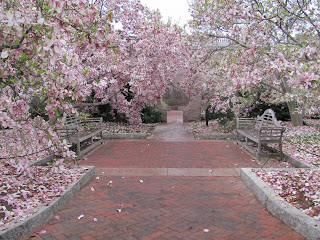Immediately after moving into my new place last December, I began to design a landscape for the very small balcony space. The dimensions of the space are about 5'x10' so there isn't much room. I also decided I was not going to get into dealing with veggies -- the space is too small. Instead, I began thinking of ways I could get as much mileage out of the plants I selected -- I wanted a big visual effect, without cluttering the space and losing square footage for furniture.

Imagine my pleasure when I saw that these 7 gallon containers (from the boxwood I planted at my folks' place) fit so perfectly in this vinyl chest I found at target. The chest was being sold as a storage container for seat cushions and other outdoor furnishings, but by unscrewing the lid, it make a great planter. It's also far cheaper than getting a custom fiberglass trough (something I was idly considering). The chest's bottom sits about 1.5" above the ground, so I filled tupperware containers with styrofoam peanuts to support the weight of the pots and not destroy the "planter's" bottom.
As far as the plant selection, as I had
considered in an earlier post, I decided to use
Forsythia. All the reasons I'd avoid using this plant in a landscape made it a perfect candidate here: I wanted something that was inexpensive, fast growing, drought tolerant, cold tolerant (I'm hoping they overwinter in the pots due to the warmer balcony microclimate) and something that could be worked as an espalier plant. I have yet to see an espalier
Forsythia but I knew the plant was "bendy" enough to handle being wired to the trellises I had bought at Home Depot. Eventually, I will pick up some moss to cover the pots and further the illusion that this is one unified trough planter.
Last of course, lighting. The building doesn't have GFI's on the balcony and I didn't want to have the wall mounted fixture on -- it's glaringly bright. The perfect solution: solar powered twinkle lights. I bought one strand and tested it for a week or two -- it seemed to collect enough sunlight to power the battery until around 3AM. After a few nights, I bought another string.
It's hard to see in the photo above but they do cast a lovely soft glow, definitely enough to see the face of the person you're sharing a glass of wine with. I still need to putter around with a more careful placement of the individual bulbs, but I foresee many pleasant summer nights on this balcony! The photo below is a night shot, but with a flash.
I need furniture, but I haven't quite decided what I want yet. I'm thinking metal bistro table and chairs for meals and working, but haven't found a set I love. More on that to come. Overall I'm quite happy. The
forsythia is pleasant enough in the spring but I'm looking forward to having a green wall all summer long. I also am enjoying the instant effect that comes with its size. Finally, as frequently as I travel, I am fairly certain this will weather drought. And since I may not be in this apartment for long, I won't be disappointed when I demo this, as I may have if it was an espalier apple or magnolia.






















































